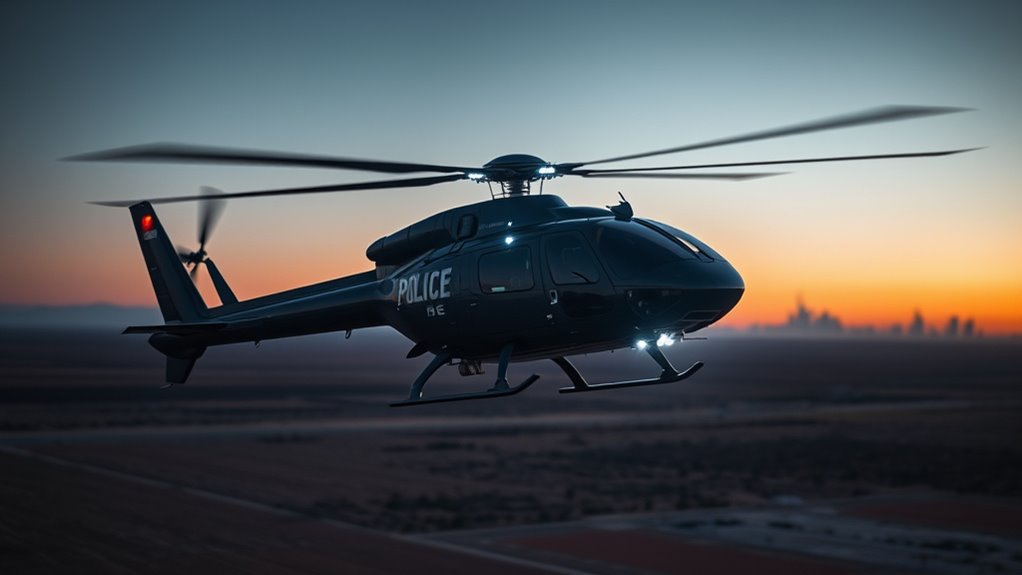Texas has deployed AI-powered police helicopters equipped with advanced sensors and real-time data analysis to boost surveillance and law enforcement efforts. While these technologies enhance monitoring and response, they also raise serious privacy and civil liberties concerns. Many worry about unchecked citizen monitoring, data misuse, and the potential for abuse. If you want to understand how these systems work and the debates they trigger, there’s more to explore.
Key Takeaways
- Texas has introduced AI-powered police helicopters equipped with advanced sensors for enhanced law enforcement surveillance.
- The deployment raises privacy concerns over potential citizen monitoring and data collection without consent.
- Civil liberties groups question the transparency and oversight of AI systems used in aerial surveillance.
- Ethical issues include risks of misidentification, false positives, and misuse of collected data.
- The move sparks public debates on balancing technological advancements with privacy rights and civil liberties.

In Texas, police departments are increasingly turning to AI-powered helicopters to enhance surveillance and response capabilities. These advanced aircraft are equipped with sophisticated sensors, real-time data processing, and AI algorithms that help officers identify potential threats more quickly and accurately from the sky. While this technology promises to improve public safety, it also raises significant privacy concerns. As you consider the implications, it’s clear that balancing effective law enforcement with respecting individual rights is a complex challenge. Critics argue that deploying AI-driven aerial surveillance can lead to unwarranted monitoring of citizens, infringing on their privacy rights without transparent oversight. The risk of constant surveillance might create a chilling effect, discouraging lawful activities due to fear of being watched. Furthermore, there’s worry about how data collected by these helicopters is stored, shared, and used, especially if it falls into the wrong hands or is used for purposes beyond immediate law enforcement needs.
Technological ethics come into play heavily here, as authorities must decide how to deploy AI helicopters responsibly. You might wonder who sets the boundaries—are there clear policies guiding when and where these helicopters can fly? Is there oversight to prevent misuse or abuse? The ethical questions extend to the accuracy of AI systems themselves. False positives, misidentifications, or technical glitches could lead to wrongful accusations or unnecessary invasions of privacy. Transparency about the technology’s capabilities and limitations is essential, yet often lacking, fueling distrust among the public. As these helicopters gather vast amounts of data, questions about consent and the scope of surveillance become even more pressing. Citizens deserve to know how their privacy is protected and what safeguards exist to prevent misuse. Incorporating high refresh rates in AI systems can also improve real-time decision-making accuracy, further enhancing their effectiveness.
Furthermore, the development and deployment of AI police helicopters reflect broader debates about technological ethics in policing. Are we relying too heavily on automation, risking depersonalizing law enforcement, or losing sight of constitutional protections? The integration of AI must be carefully balanced with legal standards that safeguard civil liberties. As you observe these developments, it’s crucial to recognize that technology alone cannot solve all issues; responsible use, clear policies, and ongoing oversight are key to ensuring that these innovations serve public safety without eroding fundamental rights. Ultimately, the adoption of AI-powered helicopters in Texas underscores the urgent need for a thoughtful dialogue about privacy, ethics, and the role of technology in modern policing.
Frequently Asked Questions
How Effective Are Ai-Powered Police Helicopters in Crime Prevention?
AI-powered police helicopters can be quite effective in crime prevention, especially with facial recognition and drone integration. You’ll notice they can quickly identify suspects and monitor large areas, making it easier to respond swiftly. However, their effectiveness depends on proper deployment and public trust. While they enhance surveillance, you should also consider privacy concerns and potential misuse, which could impact their overall success in crime prevention efforts.
What Privacy Laws Regulate Surveillance From AI Police Helicopters?
You should know that privacy legislation and surveillance regulations govern your rights regarding AI-powered police helicopter surveillance. These laws aim to protect your privacy by setting limits on data collection, monitoring, and usage. However, enforcement varies by jurisdiction, and some regulations may not fully address AI surveillance. It’s important to stay informed about local laws, as they determine how your privacy is protected against aerial surveillance technologies.
Are There Any Known Technical Limitations of These AI Helicopter Systems?
You should know that these AI helicopter systems aren’t flawless; they can suffer from system malfunctions that cause misidentifications or missed targets. Data security remains a concern, as vulnerabilities could expose sensitive information. Like a ship steering treacherous waters, these systems face challenges that could compromise their effectiveness. Recognizing these limitations helps you understand the potential risks and the importance of ongoing improvements for reliable surveillance.
How Do Communities Perceive the Deployment of AI Surveillance Technology?
You might find that many communities have mixed feelings about AI surveillance technology. Some residents express concerns about public trust, fearing invasions of privacy and potential misuse. Others show community resistance, worried that increased surveillance could target marginalized groups unfairly. Overall, perceptions vary widely, but building transparency and involving the community in decision-making can help improve public trust and ease resistance to these new technologies.
What Are the Costs Associated With Operating Ai-Powered Police Helicopters?
You should consider the cost analysis of operating AI-powered police helicopters, which involves expenses like advanced technology, maintenance, and specialized personnel. These costs can substantially impact your budget implications, requiring reallocations or increased funding. Additionally, ongoing training and software updates add to the operational expenses, making it essential for you to evaluate whether the benefits outweigh the costs beforehand. This ensures responsible resource management and effective policing strategies.
Conclusion
You can’t ignore the increasing influence of AI in aviation and apprehension. Texas’s deployment of AI-powered police helicopters sparks serious surveillance debates, sparking scrutiny and skepticism. As authorities adopt advanced algorithms, questions about privacy and potential pitfalls proliferate. Ultimately, you must weigh the wonder of technological progress against the worries of widespread watchfulness. Will this new aerial alliance truly protect or mainly invade? Only time will tell if technology triumphs or troubles our trust.











